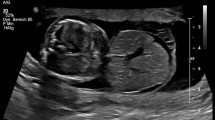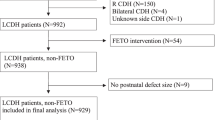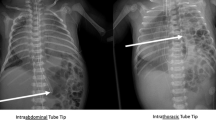Abstract
Objective
To characterize factors associated with adverse neonatal outcomes in prenatally diagnosed omphalocele cases.
Study design
Prenatally diagnosed omphalocele cases at a single referral center from 1 January 2009 to 31 December 2017 were retrospectively reviewed. Clinical variables and antenatal imaging measurements were collected. Associations between prenatal and neonatal characteristics and the adverse outcome of death or prolonged length of stay (LOS) were analyzed.
Results
Out of 63 fetal cases, 33 were live-born, > 50% had other anomalies, and neonatal mortality was 12%. Adverse outcomes were associated with neonatal variables, including lower median 1-min Apgar score, initial mechanical ventilation, and late-onset sepsis, but not approach to omphalocele closure. With multivariate analysis, death or prolonged LOS was associated only with low lung volumes by fetal MRI (OR 34 (3–422), p = 0.006).
Conclusion
Low lung volumes by fetal MRI were associated with death or prolonged LOS in neonates with prenatally diagnosed omphalocele and may guide clinicians with counseling families.
This is a preview of subscription content, access via your institution
Access options
Subscribe to this journal
Receive 12 print issues and online access
$259.00 per year
only $21.58 per issue
Buy this article
- Purchase on Springer Link
- Instant access to full article PDF
Prices may be subject to local taxes which are calculated during checkout


Similar content being viewed by others
References
Corey KM, Hornik CP, Laughon MM, McHutchison K, Clark RH, Smith PB. Frequency of anomalies and hospital outcomes in infants with gastroschisis and omphalocele. Early Hum Dev. 2014;90:421–4.
Groves R, Sunderajan L, Khan AR, Parikh D, Brain J, Samuel M. Congenital anomalies are commonly associated with exomphalos minor. J Pedia Surg. 2006;41:358–61.
Danzer E, Gerdes M, D’Agostino JA, Bernbaum J, Hoffman C, Rintoul NE, et al. Patient characteristics are important determinants of neurodevelopmental outcome during infancy in giant omphalocele. Early Hum Dev. 2015;91:187–93.
Hijkoop A, Peters NCJ, Lechner RL, van Bever Y, van Gils-Frijters APJM, Tibboel D, et al. Omphalocele: from diagnosis to growth and development at 2 years of age. Arch Dis Child Fetal Neonatal Ed. 2019;104:F18–F23.
Davis AS, Blumenfeld Y, Rubesova E, Abrajano C, El-Sayed Y, Dutta S, et al. Challenges of giant omphalocele: from fetal diagnosis to follow-up. Neoreviews. 2008;9:e338–347.
Montero FJ, Simpson LL, Brady PC, Miller RS. Fetal omphalocele ratios predict outcomes in prenatally diagnosed omphalocele. Am J Obstet Gynecol. 2011;205:284.e1–7.
Tucci M, Bard H. The associated anomalies that determine prognosis in congenital omphaloceles. Am J Obstet Gynecol. 1990;163:1646–9.
Biard J-M, Wilson RD, Johnson MP, Hedrick HL, Schwarz U, Flake AW, et al. Prenatally diagnosed giant omphaloceles: short- and long-term outcomes. Prenat Diagn. 2004;24:434–9.
Rypens F, Metens T, Rocourt N, Sonigo P, Brunelle F, Quere MP, et al. Fetal lung volume: estimation at MR imaging-initial results. Radiology. 2001;219:236–41.
Danzer E, Victoria T, Bebbington MW, Siegle J, Rintoul NE, Johnson MP, et al. Fetal MRI-calculated total lung volumes in the prediction of short-term outcome in giant omphalocele: preliminary findings. Fetal Diagn Ther. 2012;31:248–53.
Kominiarek MA, Zork N, Pierce SM, Zollinger T. Perinatal outcome in the liveborn infant with prenatally diagnosed omphalocele. Am J Perinatol. 2011;28:627–34.
Heider AL, Strauss RA, Kuller JA. Omphalocele: clinical outcomes in cases with normal karyotypes. Am J Obstet Gynecol. 2004;190:135–41.
Patel G, Sadiq J, Shenker N, Impey L, Lakhoo K. Neonatal survival of prenatally diagnosed exomphalos. Pedia Surg Int. 2009;25:413–6.
Akinkuotu AC, Sheikh F, Olutoye OO, Lee TC, Fernandes CJ, Welty SE, et al. Giant omphaloceles: surgical management and perinatal outcomes. J Surg Res. 2015;198:388–92.
Porter A, Benson CB, Hawley P, Wilkins-Haug L. Outcome of fetuses with a prenatal ultrasound diagnosis of isolated omphalocele. Prenat Diagn. 2009;29:668–73.
Tsakayannis DE, Zurakowski D, Lillehei CW. Respiratory insufficiency at birth: a predictor of mortality for infants with omphalocele. J Pedia Surg. 1996;31:1088–90.
Baerg JE, Thorpe DL, Sharp NE, Ramlogan SR, Hutson SM, Goff DA, et al. Pulmonary hypertension predicts mortality in infants with omphalocele. J Neonatal Perinat Med. 2015;8:333–8.
Mitanchez D, Walter-Nicolet E, Humblot A, Rousseau V, Revillon Y, Hubert P. Neonatal care in patients with giant ompholocele: arduous management but favorable outcomes. J Pedia Surg. 2010;45:1727–33.
Saxena AK, Raicevic M. Predictors of mortality in neonates with giant omphaloceles. Minerva Pedia. 2018;70:289–95.
Lee SL, Beyer TD, Kim SS, Waldhausen JHT, Healey PJ, Sawin RS, et al. Initial nonoperative management and delayed closure for treatment of giant omphaloceles. J Pedia Surg. 2006;41:1846–9.
Zamora IJ, Olutoye OO, Cass DL, Fallon SC, Lazar DA, Cassady CI, et al. Prenatal MRI fetal lung volumes and percent liver herniation predict pulmonary morbidity in congenital diaphragmatic hernia (CDH). J Pedia Surg. 2014;49:688–93.
Kiyohara MY, Brizot ML, Liao AW, Francisco RPV, Tannuri ACA, Krebs VLJ, et al. Should we measure fetal omphalocele diameter for prediction of perinatal outcome? Fetal Diagn Ther. 2014;35:44–50.
Kleinrouweler CE, Kuijper CF, van Zalen-Sprock MM, Mathijssen IB, Bilardo CM, Pajkrt E. Characteristics and outcome and the omphalocele circumference/abdominal circumference ratio in prenatally diagnosed fetal omphalocele. Fetal Diagn Ther. 2011;30:60–69.
Acknowledgements
The authors wish to thank the Fetal and Pregnancy Health Program at Stanford for facilitating identification of cases for this paper.
Author information
Authors and Affiliations
Corresponding author
Ethics declarations
Conflict of interest
The authors declare that they have no conflict of interest.
Additional information
Publisher’s note: Springer Nature remains neutral with regard to jurisdictional claims in published maps and institutional affiliations.
Rights and permissions
About this article
Cite this article
Chock, V.Y., Davis, A.S., Cho, SH. et al. Prenatally diagnosed omphalocele: characteristics associated with adverse neonatal outcomes. J Perinatol 39, 1111–1117 (2019). https://doi.org/10.1038/s41372-019-0410-1
Received:
Revised:
Accepted:
Published:
Issue Date:
DOI: https://doi.org/10.1038/s41372-019-0410-1



